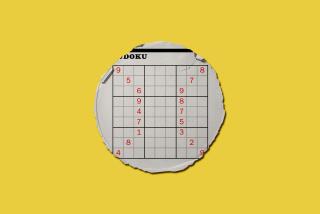Sudoku ku-ku
- Share via
WELCOME TO the exciting world of Sudoku! If you’ve been clamoring for a puzzle that combines the thrill of inputting the numbers 1 through 4 with the adventure of inputting the numbers 5 through 8, with the added twist of occasionally inputting the number 9, then Sudoku is for you.
No doubt you’ve noticed the Sudoku craze sweeping our nation since newspapers such as this one began printing these brainteasers. You may find this mania over a number puzzle to be annoyingly elitist, much along the lines of people who harmonize when they sing “Happy Birthday,” or the way National Public Radio’s Michele Norris pronounces her name. But really, Sudokus are for rote drudgery-lovers of all backgrounds.
The word “Sudoku” comes from the Japanese words “sudo,” meaning “a 9-by-9 grid,” and “ku,” meaning “one must complete so that each row, column and subgroup of 3-by-3 squares contains exactly one of each digit from 1 through 9 in it.”
If you succeed in this task, you are rewarded with a hollow, vaguely dissatisfied feeling about the way you’ve just spent your time.
The difficulty of Sudokus can range from “gentle” to “diabolical,” although every one I’ve encountered must have had some problem with it, because not even a genius could have solved it.
A vociferous debate rages between crossword enthusiasts and Sudoku solvers over which are the better puzzles. I think we can all agree that the true answer is, “My God, you guys are a bunch of dorks.”
Part of the appeal of Sudokus is their almost limitless variety. For example, one day the solution to a column might be a relatively benign 895/271/643, while the next day that same column throws you a deadly numeric curve ball of 471/932/856!
Sudokus are a thoroughly modern invention. In fact, Sudokus would not have been possible at all before 1916, when what is believed to be the final digit -- “8” -- was discovered. Should the existence of an 11th digit be confirmed -- claimed by some to lie between 4 and 5 -- the Sudoku would have to be modified.
A good grasp of logic is key for navigating the many twists in a typical Sudoku. For example, in the section of puzzle below, one can conclude that the shaded square must be a 4. Why?
The answer is, “because there’s a ‘4’ written inside that square.”
At times, filling in Sudokus can seem like a form of magic. Especially if magic bores you to tears. I’m not bitter at all that I can’t do them!
Let’s try one more. What’s wrong with this row?
The answer is nothing, because it’s not a Sudoku puzzle -- it’s my ex-girlfriend’s Social Security number. Feel free to use it any way you see fit.
Sudoku solvers have developed a number of tricks for solving puzzles more quickly, which is odd, because it’s not like they have to hurry up for a date later on. Regardless, here are two tips to help get you started.
* The Tommy Tutone rule: If you encounter a row that reads
then the digit following the 0 must, by necessity, be a 9, as in the 1982 song.
* Error correction: Occasionally you may reach a contradiction, which means you’ve made a logical error. Rather than starting over, an effective shortcut is to crumple the page into a tight ball and throw it at the dog. Using this technique, I’ve cut my own daily solving time to mere minutes. So give Sudoku puzzles a whirl, and soon you too will be exclaiming with delight: “This is so stupid! So, so stupid! I’d rather be reading the bridge column.”

